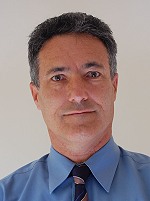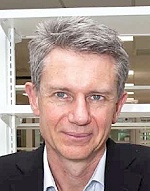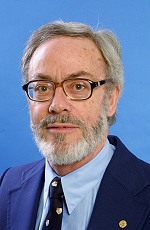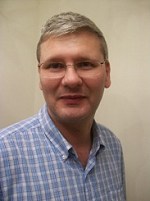|
Conference Secretariat
Conferences and Events PO Box 24 078 Mail Centre Manners St Wellington Phone: 04 384 1511 Email: [email protected] Website www.confer.co.nz Exhibitors Boutiq COST IRL IZON Lastek Magritek MEP Instruments Ltd RF Test Solutions Ltd Scimed Sigma-Aldrich |
Plenary Speakers  Professor Tadafumi Adschiri Professor Tadafumi AdschiriProf. Adschiri was graduated from the university of Tokyo in 1981 and has got the phD degree there in 1986. After working as a special fellow of JSPS, he became an assistant professor in the University of Tokyo in 1987. Till then, his main research has been for new technology for energy. In 1989, he moved to Tohoku University, and started the study on reactions in supercritical fluids, including biomass conversion, chemical recycle of wastes, new organic reactions and materials synthesis. He is the inventor of supercritical hydrothermal synthesis for nanoparticles. For his excellent research, he was awarded with many prizes including the awards from the Chemical Society Japan, Chemical Engineering Society of Japan, Japan Energy Society, and two minister’s awards of MEXT (Ministry of Education, Culture, Sports, Science and Technology). Now he is leading a big national project (30 million US dollars) in Japan, for Super Hybrid Nanomaterials, using supercritical water.  Professor Jas Pal Badyal Professor Jas Pal BadyalProfessor Jas Pal Badyal obtained BA/MA (1985) and PhD (1988) degrees at Cambridge University; where he subsequently held a King’s College Fellowship and the Oppenheimer Fellowship. In 1989 he moved to Durham University to take up a lectureship and was promoted to Professor in 1996. He has published 152 refereed research articles and is the first named inventor on 29 patents. He has been recipient of the Harrison Prize from The Royal Society of Chemistry; Burch Prize from The British Vacuum Council; and an EPSRC Advanced Research Fellowship. His research has directly led to 3 spin-off companies: Dow Corning Plasma Ltd (atmospheric plasma processing), P2i Ltd (super-repellent surfaces), and Surface Innovations Ltd (bioactive coatings).  Professor Richard Blaikie Professor Richard BlaikieDirector MacDiarmid Institute for Advanced Materials and Nanotechnology Department of Electrical and Computer Engineering, Canterbury University Richard Blaikie received a B.Sc. from the University of Otago in 1988 and a Ph.D. in physics from the University of Cambridge in 1992. He was a scientist at the Hitachi Cambridge Laboratory before returning to New Zealand in 1993, taking up a position in the Department of Electrical and Computer Engineering at the University of Canterbury. He is currently the Director of the MacDiarmid Institute for Advanced Materials and Nanotechnology, a New Zealand Centre of Research Excellence. His principal research interests are the investigation of nano-scale imaging techniques using near-field light and other sub-wavelength optical phenomena. This research led to the award of the 2001 T.K. Sidey Medal, and in 2005 he and colleague David Melville were the first to report superlensing at optical wavelengths using thin silver films.  Professor Sally Brooker Professor Sally BrookerSally Brooker graduated BSc(Hons) first class and PhD (supervisor Professor Vickie McKee) from the University of Canterbury. After postdoctoral research at the University of Goettingen with Professor George Sheldrick, she accepted a lectureship at the University of Otago where she is now a Professor. Her research interests concern the design, synthesis and full characterisation of, primarily paramagnetic, di and polymetallic complexes of transition and/or lanthanide metal ions with new polydentate and macrocyclic ligands. Website: http://neon.otago.ac.nz/research/sab/sab-res.htm  Professor Michael Cortie Professor Michael CortieMichael Cortie is Professor of Nanotechnology and Director of the Institute for Nanoscale Technology at the University of Technology Sydney, in Australia. He was born and educated in South Africa, with a BSc(Eng) degree in physical metallurgy from the University of the Witwatersrand, Johannesburg, in 1978, a Masters degree on the corrosion of zirconium nuclear fuel elements from the University of Pretoria in 1983, and a PhD degree on metal fatigue at high temperatures from the University of the Witwatersrand in 1987. After some years at South Africa's Atomic Energy Corporation, Michael worked in a gear-cutting works, and then joined Mintek, the South African national minerals and metals research organization. He was a Senior Engineer there before finally becoming head of its Physical Metallurgy Division between 1997 and 2002. During his 15 years at Mintek, he worked on ferritic and nickel-substituted stainless steels, on X-ray diffraction and crystallographic texture of bcc and fcc alloys, on cellular automata and the simulation of metal solidification, cracking and solid state transformations, on explosive interactions between molten metal and water, on displacive transformations in Pt-containing alloys and compounds, and on the catalytic properties of gold. He has consulted widely to the international precious metals industry and developed a deep interest in the science and applications of the coinage and platinum group metals. He relocated to Australia and took up his present position in July 2002. Michael’s main research interest now is the nanoparticles and intermetallic compounds of the precious metals, especially as this relates to their optical properties. He has completed a number of government and industry-supported projects in this area. Michael Cortie is a Member of the Institution of Engineers Australia, in the Professional Engineer category, a Member of the Australian Institute of Physics, and a Member of Institute of Materials Engineering Australasia.  Professor Dragan Damjanovic Professor Dragan DamjanovicDragan Damjanovic received his BSc diploma in physics (summa cum laude; 1980) from University of Sarajevo and PhD in ceramics science (1987) from the Pennsylvania State University. After a postdoctoral stay at the Materials Research Laboratory at the Pennsylvania State University (1988-1991) he joined the Ceramics Laboratory, Institute of Materials, at the Swiss Federal Institute of Technology in Lausanne – EPFL (1991), where he is now an adjunct professor. His research work and teaching are centred on piezoelectric, dielectric and ferroelectric properties of ceramics, single crystals, thick and thin films and their applications. He is associate editor of IEEE Transactions on Ultrasonics, Ferroelectrics and Frequency Control (UFFC), Journal of American Ceramic Society, Journal of Electroceramics and Journal of Advanced Dielectrics. He has authored more than 170 publications. In the last ten years he participated in or co-directed eighteen Swiss and European research projects. He was awarded ISIF outstanding achievement award in 2007, received ferroelectrics recognition award of the IEEE UFFC Society in 2009, was elected a fellow of IEEE in 2009, and serves as a distinguished lecturer of the IEEE UFFC Society for period 2010/11.  David Deamer David DeamerDavid Deamer is a Research Professor in the Department of Biomolecular Engineering at the University of California, Santa Cruz. His undergraduate B.Sc. degree was in Chemistry, at Duke University, Durham NC (1961) and his Ph.D. in Physiological Chemistry from the Ohio State University School of Medicine (1965). Following post-doctoral research at UC Berkeley, he joined the faculty at UC Davis in 1967. In 1994 Prof. Deamer moved his laboratory to UC Santa Cruz, where his research focuses on DNA transport through nanoscopic pores in membranes. Prof. Deamer serves on the scientific advisory board of Oxford Nanopore Technologies, a British company that is developing an instrument capable of analyzing single molecules of nucleic acids.  Rod Dunbar Rod DunbarRod Dunbar graduated MBChB from the University of Otago, and later completed a PhD in immunology at the Wellington School of Medicine. After 6 years at Oxford University’s Institute of Molecular Medicine, he returned to NZ under a Wellcome Trust International Senior Research Fellowship, to establish his laboratory at the University of Auckland’s School of Biological Sciences. Dr Dunbar’s current research encompasses a multi-disciplinary programme to develop new immunotherapies for cancer and investigate the use of primary human cells in medicine. In 2008 he was appointed the Director of the Maurice Wilkins Centre for Molecular Biodiscovery, a New Zealand Centre of Research Excellence, and he also co-directs a Thematic Research Initiative at the University of Auckland to develop the university’s biopharma-related research.  Professor Martin Green Professor Martin GreenMartin Green is currently a Federation Fellow and Scientia Professor at the University of New South Wales and Executive Research Director of the ARC Photovoltaic Centre of Excellence. He is also a Director of CSG Solar, a company formed specifically to commercialise the University’s thin-film, polycrystalline-silicon-on-glass solar cell. His group's contributions to photovoltaics are well known including the development of the world’s highest efficiency silicon solar cells and the successes of several spin-off companies. He is the author of six books on solar cells and numerous papers in the area of semiconductors, microelectronics, optoelectronics and, of course, solar cells. His work has resulted in several major awards including the 1999 Australia Prize, the 2002 Right Livelihood Award (also known as the Alternative Nobel Prize), the 2004 World Technology Award for Energy, the 2007 SolarWorld Einstein Award, the 2009 Zayed Future Energy Prize (one of two finalists), the 2009 ENI Award for Renewable and Non-conventional Energy and the 2010 Eureka Prize awarded by Australian Museum for Leadership in Science.  Professor Tomas Jungwirth Professor Tomas JungwirthBorn: October 23, 1967, Praha, Czech Republic. Home page: http://www.fzu.cz/~jungw Affiliations: Head of the Dept. of Spintronics and Nanoelectronics, Institute of Physics ASCR, Prague, Czech Republic; Professor, University of Nottingham, Nottingham, United Kingdom Professional experience: Condensed matter physics; materials science; metal and semiconductor spintronics. Accomplishments: 135 publications in international peer-reviewed journals (including 20 Physical Review Letters, Nature, Nature Materials, Nature Physics, and Reviews of Modern Physics articles); 5000 citations in the scientific literature; h-index 35; member of the Learned Society of the Czech Republic.  Professor Safa Kasap Professor Safa KasapBorn in 1953, Safa Kasap grew up in London, England, and obtained a BSc (1976) and PhD (1983) from the Imperial College of Science and Technology at the University of London, specializing in optoelectronic materials and devices. In July, 1986, Professor Kasap joined the University of Saskatchewan (U of S) as an assistant professor in the Department of Electrical Engineering, and in July 1992 he was made a full professor. During a sabbatical from the U of S (1997), Professor Kasap was a Visiting Research Scientist with Dr. John Rowlands where they jointly wrote a number of articles on direct conversion detectors, including the Physics Today feature article that was published in November 1997. In 2002, he was named a Canada Research Chair (Tier 1) in Electronic and Optoelectronic Materials and Devices. In addition to two well-known textbooks on electronic materials and devices, and optoelectronics and photonics (with translations in Greek, Korean and Chinese), and numerous chapters in books, handbooks and encyclopedias and reviews, Safa has published more than two hundred articles in refereed international journals, as well as invited papers in a number of prestigious journals. Since 2000, he has been the Deputy Editor for J. Materials Science: Materials in Electronics (Springer). Among Professor Kasap’s honours and awards received to date is a DSc in Engineering (1996) from the University of London, for his distinct contributions to materials science in electrical engineering. He is a Fellow of the Royal Society of Canada, the Canadian Academy of Engineering, the Engineering Institute of Canada, SPIE (the International Society of Optical Engineering), the American Physical Society, the Institution of Electrical Engineers (now the Institution of Engineering and Technology), the Institute of Materials (IOM3), the Institute of Physics, and the Society for Glass Technology. Recently, he was awarded a Fellow of the City and Guilds London Institute (FCGI) in the UK; FCGI is only given to a few individuals who have been recognized for their societal contributions, including contributions to education and vocational training.  Professor Brian A. Korgel Professor Brian A. KorgelBrian A. Korgel is Cockrell School of Engineering Temple Professor #1 and Matthew Van Winkle Regents Professor of Chemical Engineering at the University of Texas at Austin (UT Austin). He received his PhD in chemical engineering at UCLA in 1997, and joined the faculty at UT Austin in 1998 after a one and a half year post doctoral position in the Department of Chemistry at University College Dublin in Ireland. In 2007, he was a Senior Fulbright Fellow at the University of Alicante in Spain in the Department of Applied Physics and in 2008 was Visiting Professor in the Department of Physics at the Universit� Josef Fourier in France. His research is in the field of nanomaterials chemistry and engineering, and he has published more than 160 journal publications and given over 145 international invited seminars and lectures. He also serves as Associate Editor for the Journal of Crystal Growth and Materials Science and Engineering: R and is a member of the editorial advisory boards of the journals Chemistry of Materials and the Journal of Colloid and Interface Science. At UT Austin, he founded the Doctoral Portfolio Program in Nanoscience and Nanotechnology and has co-founded two startup companies, Innovalight and Pi�on Technologies. back to top  Dr Franz Laermer Dr Franz Laermer Manager at Bosch Corporate R&D in the field of new Microsystems technologies and application fields since 1990, in different roles and positions. Technologies related to Silicon Microstructuring and Applications of new Materials, eg. polymers for biochip solutions. (Co-)Inventor of BOSCH-Deep Reactive Ion Etching technology.  Dr Eric Le Ru Dr Eric Le RuEric Le Ru studied physics at Ecole Polytechnique (Paris) and obtained a PhD in 2002, working at Imperial College London on semiconductor quantum dots for telecom applications. After a one-year postdoctoral position at Imperial College, he moved to New Zealand in 2004 as a postdoctoral fellow of the MacDiarmid institute, working with Pablo Etchegoin at Victoria University of Wellington. He is now a Senior Lecturer in physics at Victoria. His research focuses on various aspects, both theoretical and experimental, of nano-photonics, with a particular emphasis on nano-plasmonics; i.e. the study and applications of the optical properties of sub-wavelength metallic objects, and related applications in surface-enhanced spectroscopies (Raman and fluorescence). This work has resulted in 50 publications since 2004 and was recently complemented by the publication of a book, co-authored with Pablo Etchegoin, on surface-enhanced Raman spectroscopy.  David J. Lockwood David J. LockwoodDavid J. Lockwood obtained his Ph.D. in physics from Canterbury University, New Zealand in 1969, and he was awarded a D.Sc. in 1978 from Edinburgh University, U.K. and a D.Sc. from Canterbury University in 2000 for his work on the electronic, optical, and magnetic properties of solids. He carried out post-doctoral work in physical chemistry at Waterloo University, Canada (1970–1971), and was a Research Fellow in Edinburgh University (1972–1978) before joining the National Research Council (NRC) of Canada in 1978 where he is presently a Principal Research Officer. At NRC Lockwood’s research has centered on the optical properties of low dimensional materials and recently has focused on Group IV and III-V semiconductor quantum dots and transition-metal magnetic nanostructures. Lockwood has published more than 500 scientific articles in journals and books and has 6 U.S. patents. He is a Fellow of the Royal Society of Canada, the American Physical Society, and the Electrochemical Society and serves on the editorial boards of 6 physics journals as well as being the founding editor of the book series “Nanostructure Science and Technology”. In 2005 he was awarded the Brockhouse Medal of the Canadian Association of Physicists for outstanding achievement in condensed matter and materials physics and the Tory Medal of the Royal Society of Canada for outstanding research in any branch of astronomy, chemistry, mathematics, physics, or an allied science. In 2008 he received the Exact and Natural Sciences Award of the Academy of Sciences of Cuba and in 2010 the Electrochemical Society Luminescence and Display Materials Division Centennial Outstanding Achievement Award.  Kathryn McGrath Assoc Prof Kathryn McGrath Assoc ProfKathryn McGrath is an Associate Professor in the School of Chemical and Physical Sciences, Victoria University of Wellington, and a Principal Investigator in The MacDiarmid Institute for Advanced Materials and Nanotechnology. She has a BSc (Hons) degree in Chemistry (Canterbury University) and a PhD from The Australian National University (Department of Applied Mathematics), Canberra, Australia. After completing her PhD Kate took up a post-doctoral position at L’Universit� de Pierre et Marie Curie – Paris VI (Laboratoire de Mineralogie et Cristallographie), in Paris, working with Maurice Kl�man. Her second post-doc was in the Physics Department at Princeton University, Princeton, with Sol Gruner. This was followed by her joining the Department of Chemistry, University of Otago, as a lecturer. Kate stayed at Otago for six years, completing a PGDip Com in Finance in her spare time. In January 2004 she moved to Victoria University of Wellington. Kate is also an Associate Investigator in the Riddet Institute, like The MacDiarmid Institute this is a New Zealand Government Centres of Research Excellence (CORE). Kate has been heavily involved in administrative duties and leadership roles both within her School, the wider University, the MacDiarmid Institute and Nationally, most recently she was the President of the New Zealand Association of Scientists. Kate has received the Easterfield Medal, awarded jointly by the New Zealand Institute of Chemistry and The Royal Society of Chemistry, UK (2003) and the Research Medal awarded by the New Zealand Association of Scientists (2007). Her research expertise is in the areas of soft matter and biomineralisation. In particular she is interested in the fundamental molecular-level control of 3D pattern formation in liquids and solids as inspired by Nature.  Professor Donald T. Morelli Professor Donald T. MorelliDonald Morelli is Professor of Materials Science at Michigan State University and directs the MSU Energy Frontier Research Center on Revolutionary Materials for Solid State Energy Conversion. His research group emphasizes semiconductors for thermoelectric energy conversion. Dr. Morelli holds BS and PhD degrees in physics from the University of Michigan.  Professor Yung Woo Park Professor Yung Woo ParkYung Woo Park was born in Pusan, Korea in 1952. He graduate from the Seoul National University in physics in 1975 and studied his Ph.D. at the University of Pennsylvania under the guidance of Prof. Alan J. Heeger on the electrical transport of pure and doped polyacetylene. He has been an Assistant, Associate and Full Professor in the Department of Physics and Astronomy of Seoul National University since 1980. He is a fellow of the Korean Academy of Science and Technology, a foreign member of the G�teborg Royal Academy of Sciences and Arts in Sweden and a fellow of the American Physical Society in Division of Condensed Matter Physics for his contribution to the synthesis and transport in conducting polymers, carbon nanotubes, organic crystals and highly-correlated materials. He received the Brothers Jacob and Marcus Wallenberg Memory Foundation Grant administered by the Royal Swedish Academy of Sciences.  Dr Jeff Tallon Dr Jeff Tallon Dr Jeff Tallon, CNZM, FRSNZ, HonFIPENZ is internationally known for his discoveries and research in high-temperature superconductors. He is currently a Visiting Professor at the Cavendish Laboratory and a former Visiting Fellow at Trinity College, Cambridge. He has received a number of awards for his research including the Rutherford Medal and the inaugural Prime Minister's Science Award. back to top  Dr Stuart H. Taylor Dr Stuart H. Taylor Dr Stuart H. Taylor has been active in the field of heterogeneous catalysis research since he started his PhD on selective methane oxidation in 1991. He has worked extensively in the field of oxidation catalysis; current research areas focus on Volatile Organic Compound oxidation, low temperature carbon monoxide oxidation and selective oxidation of alkanes, aromatics and biorenewables. Other interests include catalyst preparation, Fischer Tropsch synthesis, environmental catalysis and mesoporous acid catalysts. He has published over 120 scientific papers and patents. He has also presented his work at numerous international conferences, including a number of keynote and invited presentations. He receives funding from the EPSRC in the UK, and a number of national and international industrial companies including Johnson Matthey, Sabic, BP, Oxford catalysts, NDA, Molecular Products, Dow and ExxonMobil. He has been visiting lecturer at the University of Wittswatersrand since 2001, and has much active collaboration, including international links with institutions in the USA and Spain. In 2007 he was awarded the IChemE Environwise prize for recognition of his work in the preparation of novel and highly active catalysts prepared using greener routes. In recognition of his expertise in the field he has been invited to undertake numerous roles. These include guest editor for Topics in Catalysis, and he has been invited as an expert for advisory panels for numerous prestigious international catalysis conferences. Within the UK he is an elected committee member of the Royal Society of Chemistry Applied Catalysis Group and Surface Reactivity and Catalysis interest groups.  Dr Michael F. Toney Dr Michael F. ToneySenior Staff Scientist and group leader for chemistry and materials sciences staff, Stanford Synchrotron Radiation Lightsource; SLAC National Accelerator Laboratory Dr Toney received his PhD in surface physics from the University of Washington in 1983. He then moved to the Risoe National Laboratory in Denmark, as a NATO Postdoctoral Fellow, where he used surface X-ray diffraction to study semiconductor surface structure. In 1984 he joined the IBM Almaden Research Division in San Jose. While at IBM, his research focused on the use of X-ray scattering methods for structure determination of polymer surfaces and of thin films and interfaces that are of importance in electrochemistry and in magnetic recording. In 2003, he joined the Stanford Synchrotron Radiation Lightsource (SSRL), where he is presently a senior staff scientist. He has the main responsibility for the x-ray scattering program at this facility and leads a team that does research focused on materials for sustainable energy using synchrotron radiation. Toney is one of the pioneers in the use of surface X-ray diffraction for in-situ investigations of atomic structure at electrode-electrolyte interfaces and of the molecular structure in organic and magnetic thin films.  Professor Gordon Wallace [FAA, FTSE, FIOP, FRACI] Professor Gordon Wallace [FAA, FTSE, FIOP, FRACI]ARC Centre of Excellence for Electromaterials Science Intelligent Polymer Research Institute University of WollongongGordon Wallace obtained his PhD from Deakin University, Geelong, Australia, in 1983. He joined the University of Wollongong in 1986 and is currently Director of the Intelligent Polymer Research Institute (http://ipri.uow.edu.au/aboutipri/index.html) and Executive Research Director of the ARC Centre of Excellence for Electromaterials Science (http://www.electromaterials.edu.au/). He is a Fellow of the Australian Academy of Science and the Australian Academy of Technological Sciences and Engineering. He has published over 500 papers and numerous patents in the areas of organic conductors, nanomaterials, the development of intelligent polymer systems, and their exploitation in medical bionics and energy production and storage.  Professor David E Williams Professor David E WilliamsProfessor David E Williams is a graduate of the University of Auckland. He developed his research career in electrochemistry and chemical sensors at the UK Atomic Energy Research Establishment, Harwell, in the 1980s. He became Thomas Graham Professor of Chemistry at University College London in 1991 and co-founded Capteur Sensors Ltd. He was Head of the Chemistry Dept at UCL from 1999-2002 and co-founded Aeroqual Ltd (www.aeroqual.com). He was Chief Scientist of Inverness Medical Innovations (www.invernessmedical.com/ ), based at Unipath Ltd, Bedford, UK, from 2002-2005. He joined the faculty of the Chemistry Dept at Auckland University in February 2006. He is a Visiting Professor at University College London and University of Southampton, and Honorary Professor of the Royal Institution of Great Britain, and has been Visiting Professor at University of Toronto and Cranfield University of Technology. He is a Principal Investigator of the MacDiarmid Institute (NZ), and of the Biomedical Diagnostics Institute at Dublin City University. He has published around 200 papers in international journals, on corrosion science, gas sensors, electrochemistry, and miniature bioassay devices. He is inventor on around 40 patents. back to top |
Platinum Sponsors   Gold Sponsors  Bronze Sponsors  General Sponsors     |
